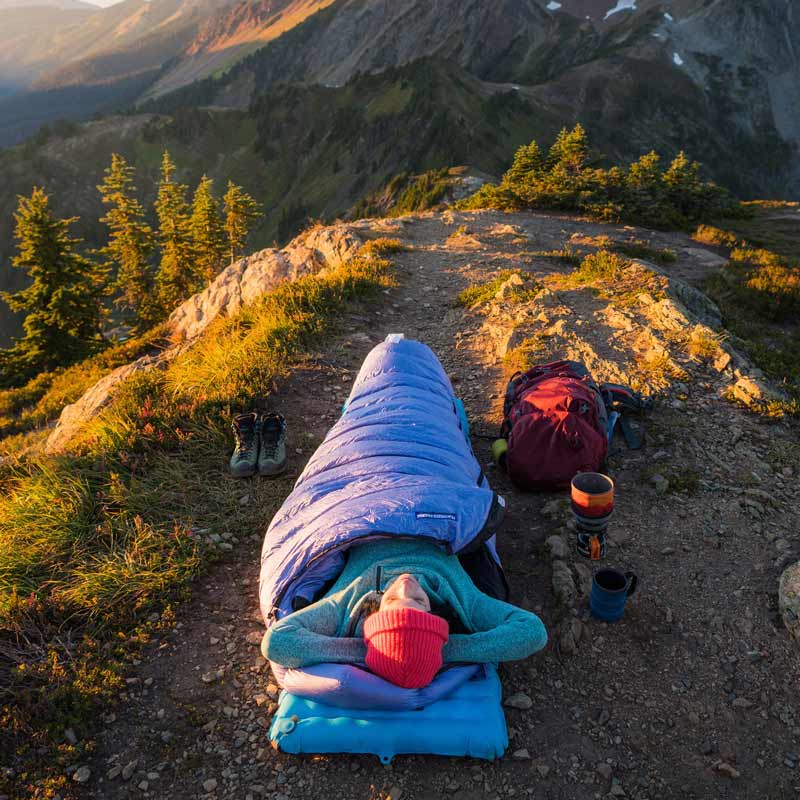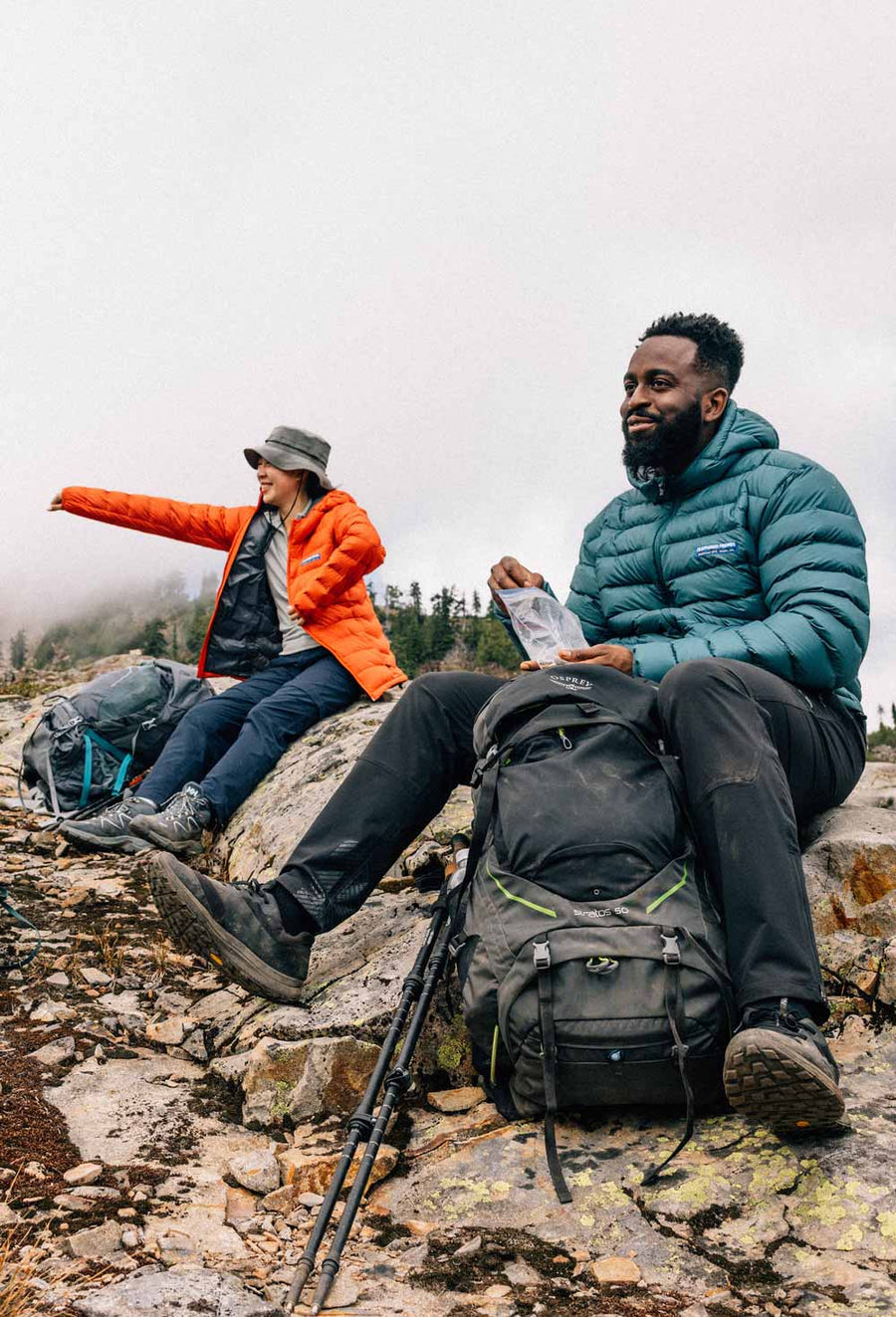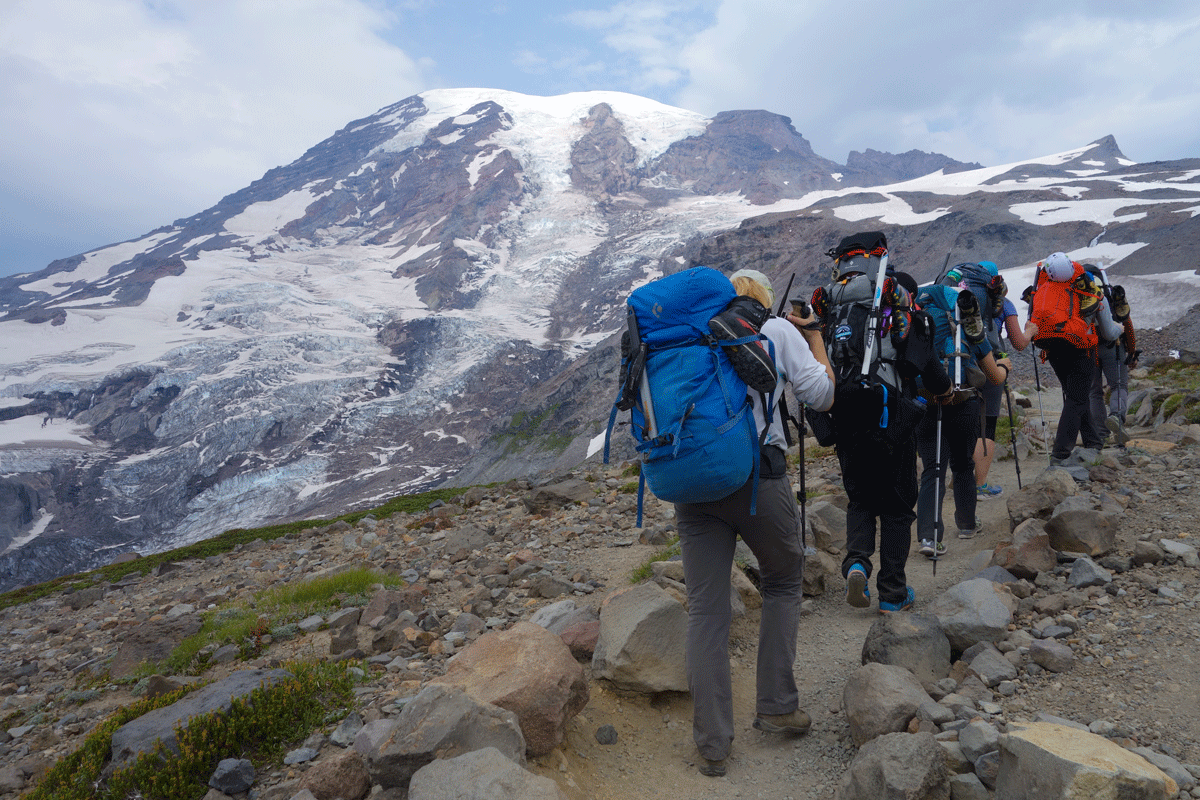How to Have Fun Climbing Mount Rainier
Thinking about climbing Mount Rainier this summer season? Here are a few lessons learned the hard way. Text and images by Claire Giordano.
Every summit bid is different, even on the same route. Each time we venture into the mountains we move out of our safe, comfortable, and controlled environments into a setting where we are surrounded by factors out of our control. From weather to snowpack to our fellow team members, the mountains strip away the conveniences and routines of everyday life and test our knowledge, resilience, and judgement. With so many unknowns, we have a much higher chance of success if we prepare for the factors that we can control.
1. Prepare your mind as well as your body.
Mount Rainier is one of the most stunning mountains in the country, rising from conifer foothills to its white snowy peak at 14,416 feet above sea level. It also has a reputation for being a bit of a sufferfest. In order to find the fun in this kind of ascent, our bodies and minds have to be up for the challenge.
Before my climb, the majority of mytraining focused on strengthening my body. For six months I did one to two longer hikes each week with a heavy pack, increasing the weight by set increments. In between, I biked to work, did yoga, ran hills, and jogged stairs. I tried to keep as active as possible, while also listening carefully to the aches and pains in my body and taking rest days as needed. The months of preparation meant I could go into my climb confident in my body’s abilities.
This confidence is only part of the preparation, however, because the mind has to be strong enough to motivate the body to work. Unlike my previous summer mountaineering trips, this one was cold…really cold (at least for me). 5 degrees fahrenheit ambient temperature and 50 mph winds. Cold enough that I had to leave a sweater in my pack wrapped around my water bottles, and my frozen bagel required a fair bit of gnawing and slobber to eat. There is nothing quite like cold to sap one’s motivation. And added on top was the darkness, thrilling and terrifying at the same time. At each crevasse crossing, my headlamp would dance shadows across of the icy walls, the bottom invisible below.
In these conditions, the ascent became centered on maintaining focus as I put one spikey boot in front of the other spikey boot that always liked to trip me. My longer hikes (slogs) with my pack had prepared me somewhat for this, but ultimately it was yoga that helped me to stay focused and keep a good attitude. I turned to a repeated mantra, or a short phrase, to guide my focus, modulate my breathing, and keep my thoughts on the present moment. In staying attentive to the mist of my breath in my headlamp, the crunch of snow in my crampons, and the coolness of my ice axe griped in a thick glove, I was experiencing every moment. And while not every moment was a bonanza of joy, the overall climb was much more enjoyable because I kept a positive attitude.
2. Food. Food. And more food.
An ultra runner once told me that whoever can eat the most in the shortest amount of time wins. I think mountaineering also adheres to this theory. The surest way to ruin a fun day is to get too hungry and cranky. Not only does a hungry tummy make us pissed off at everything, but it also seems to reduce our mental acuity and focus. I can always tell when I am hungry because my inner dialogue shifts from “look at that pretty icicle” to “when will I be off this dumb slippery bad idea of a route?”
Before you climb, spend a lot of time trying different foods on your hikes. For years I swore by protein bars of various manufacturers, until I tried to eat one that was frozen solid. Never again. I now go for bagels and other easy to eat carb and sugar loaded things like pastries, bread, dried fruit, nuts, and cookies or even some energy chews. The mountains have a weird ability to take away the appetite, so finding things you will actually eat is another foundation of a successful ascent.
I stop every hour at most, and try to take in at least 300 calories. In the cold this was a lot harder, however, so I pre-loaded with a huge breakfast of oatmeal, nuts, and dried fruit. With that on board, I was ok eating only about 150 calories an hour to the top, and then switched back to normal intake amounts on the way down.
My personal favorite: bagels. Bagels with peanut butter, bagels with salami, bagels with sirracha… anything that makes those carbs taste good, even when frozen-ish.
3. Learn how to pee in the cold.
Ok, this one is mostly for the other adventurous ladies out there, but learn how to use a funnel. Many guiding companies will recommend this, and they are 100% correct. I will never, ever, ever have my bare butt out in 50 mph wind and blasted by ice pellets. Its is as unpleasant as it sounds. And you moon everyone, all the time, since you are stuck to each other with ropes and simply can’t wander far on a crevassed glacier. Not to mention that the de-layer and re-layering process is made 100x harder by a harness. So, trust me, it is worth it to put in the time and become a pro at peein like a man.
4. Become an expert napper.
This is a skill best honed over many months, so start now. On my trip, I was the only one who got decent sleep, and it made a huge difference. I was much more chipper after our summit and nearly 10,000 vertical feet of descending than my teammates. I attribute it to my high school days of taking 30 minute naps during late-night study sessions. Like any other skill, napping requires practice to not only fall asleep quickly, but also to train the body to feel rested after only 30 min.
I recommend learning some kind of meditation technique to help put you to sleep. This can be as simple as intentional breathing, or as complex as a mental check-in with each part of the body (or a body-scan meditation). While many people make summit pushes on zero sleep, even a few hours can make a huge difference in how energetic you feel, and how much fun you will be having once the adrenaline of the ascent wears off.
4. Focus on your breathing.
We take it for granted that our bodies will breathe. They do it all day, every day, for our entire lives. Sometimes, however, our bodies need a little extra help to do it right.
At low altitudes and in everyday life most of us use only the upper portions of our lungs. Pause, and direct your attention to your next breath; does your chest or your belly move with each inhale? Most likely you used your chest and neck muscles only.
At elevation the body has to work harder to supply the oxygen that our working muscles require. This means that one of the easiest ways to help your body perform is to use all of that available lung capacity by belly breathing. Instead of using the auxiliary muscles of the chest and neck to inhale and exhale, use the strong diaphragm and core muscles. Outwardly, this will look like your belly is moving in and out slightly as you breathe; this is the kind of using-all-my-lung-capacity breath we want in the mountains.
This technique of diaphragmatic and regulated breathing is so important, it is taught to Navy SEALs. Before, during, and after combat many are trained to do the 4×4 breath, which is a simple breath pattern of inhale 4 seconds, hold 4 seconds, exhale 4 seconds, hold 4 seconds, and repeat. You may have to work up to a duration of 4 seconds, but practicing breathing techniques over time strengthens and stretches the body so it can breathe more efficiently, and focuses the mind.
The second main technique to use on Rainier is pressurized breathing, or a forcible exhale every so often. I ended up doing one every ten breaths. To do it, purse your lips and force the air from your body, and exhale as long as possible.
Focusing on the breathing maintains our attention and keeps us in the present, where we are more attentive and less likely to make a mistake. Happy muscles are muscles that have enough fuel and oxygen, so we need to do all we can to help them take us up and down the mountain.
5. Take moments to look around.
When climbing, I sometimes find myself in the zone of focused unfocused-ness. I am moving, aware, alert to hazards, but not truly present or observing my surroundings fully. I am in a head space oriented to ascent and descent. In these moments, I try to stop for a few seconds to look around me and notice; the colors of icicles caught in the first light of dawn, the scalloped surface of the snow, the way dark rocks silhouette against the moon. I stop, and remember why I am out here. I am here to challenge myself, to learn, and to enjoy the stunning expansive overwhelming beauty of the mountains.
The post How to Have Fun Climbing Mount Rainier appeared first on Expedition Tales.














Leave a comment